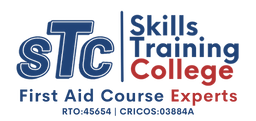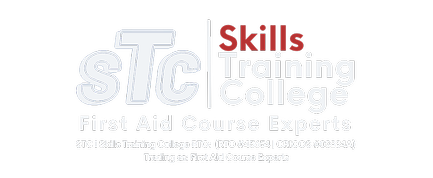First Aid For Asthma And Anaphylaxis
According to the Asthma Australia report (2021-22), over 2.7 million Australians suffer from asthma. In percentage terms, this amounts to about 11% of the total Australian population. One of Australia’s most prevalent chronic diseases, asthma, strikes people of all ages, including children.
According to the National Allergy Council, Australia has one of the world’s highest allergy rates. Anaphylaxis can occur at any age, but it is more prevalent in children. It is essential to remember that these are only estimates, and the number of individuals afflicted with asthma and anaphylaxis may differ.
But what exactly are Asthma and Anaphylaxis? Let’s get familiar with the symptoms of asthma and anaphylaxis and learn how to handle these situations safely and effectively.
What Is Asthma?
Asthma is a chronic respiratory disorder characterised by airway inflammation and constriction. Symptoms include wheezing, coughing, shortness of breath, and a tight feeling in the chest because it makes the airways hypersensitive and easily inflamed.
A wide range of environmental and internal factors and some drugs have been linked to asthma attacks. The disorder is chronic and incurable. However, it can be controlled with medication and avoiding flare-ups.
What Is Anaphylaxis?
Anaphylaxis is the most extreme form of an allergic reaction and can be fatal. The quick onset of symptoms, typically within minutes to hours of contact with an allergen. Allergies can cause many uncomfortable symptoms, including welts, swelling, wheezing, and a racing heart.
Allergens can trigger anaphylaxis, including those found in food, medication, and insect bites. Due to the seriousness of the situation, epinephrine and other drugs must be administered without delay, and the patient must be closely monitored.
Difference Between Asthma And Anaphylaxis
Asthma and anaphylaxis are two conditions that can severely impact a person’s daily life. Even though they are connected somehow, they are not the same. It is essential to clearly understand the distinction between the two in the event of any emergency. Here are some of these differences:
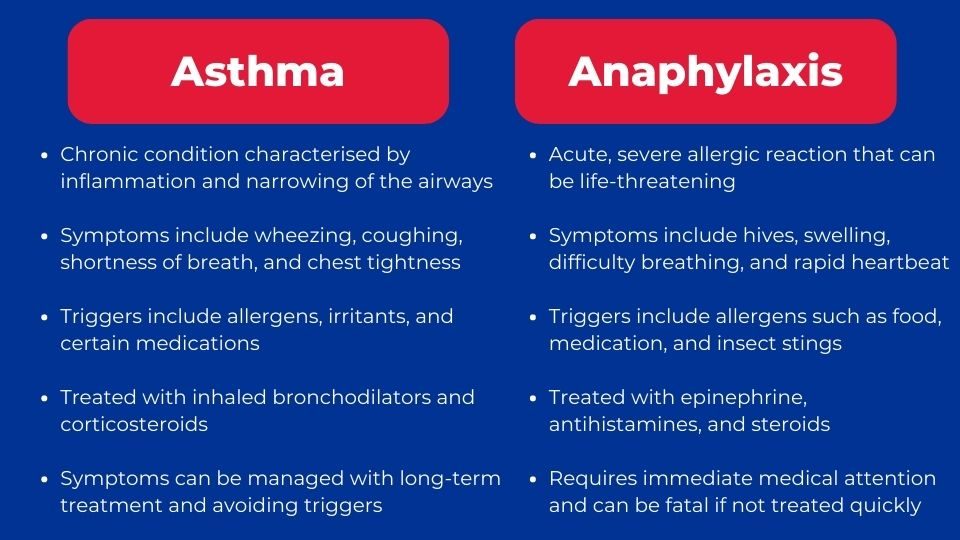
Asthma First Aid Warning Signs
If you suffer any of the symptoms listed below, follow your asthma action plan. Start with asthma first aid if you don’t have an asthma action plan or if you’re assisting someone suffering an asthma attack. Don’t wait for your asthma to worsen.
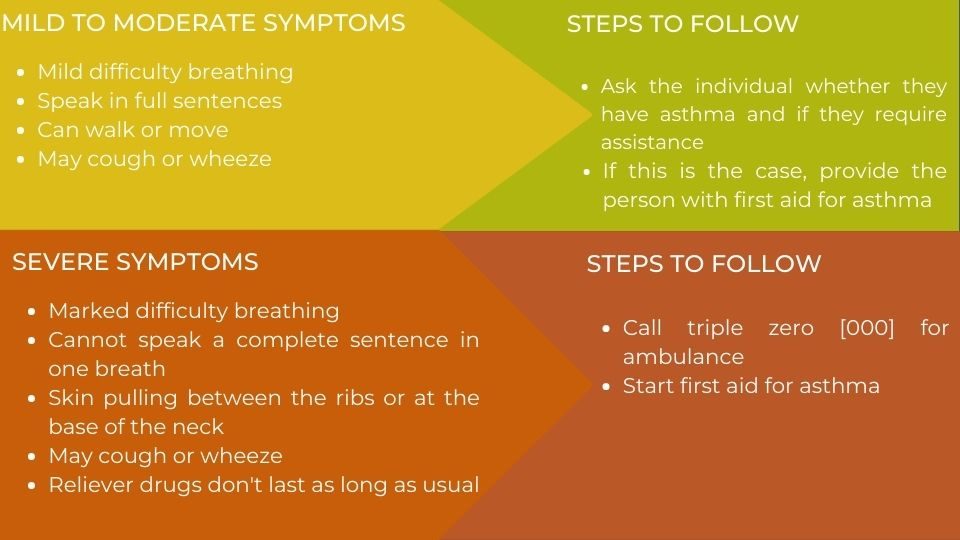
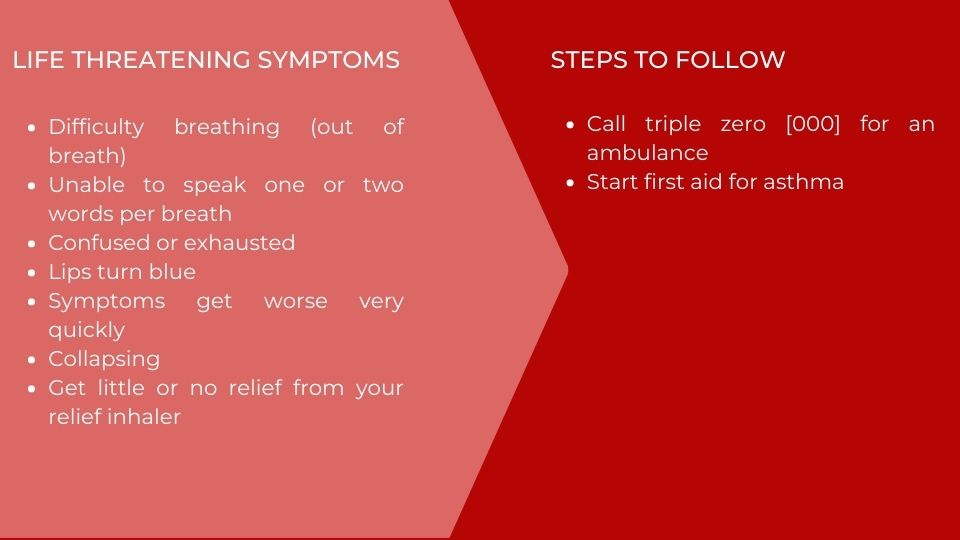
What Are The Steps Of First Aid For Asthma?
When someone has an asthma attack, it is essential to provide the right care to prevent further complications. The following measures are included in the first aid treatment for asthma:- Maintain your composure and offer reassurance to the person with an asthma attack.
- Assist the individual in sitting up straight and giving them their inhaler, if they have one.
- Emergency services should be called immediately if the person cannot use an inhaler or if the attack is severe.
- Check the person’s breathing and pulse, and look for signs of worsening symptoms such as trouble speaking, rapid heartbeat, and blue lips or fingernails.
- If you have access to oxygen, give it to them, and if a nebuliser is available, use it on them.
- Give them another dose if the person’s condition doesn’t improve after using the inhaler or nebuliser.
- Keep an eye on the patient’s condition and stay with them until help arrives.
- If the person loses consciousness, call 000 and begin CPR if you are certified.
Signs That You Need To Use Anaphylaxis First Aid
Anaphylaxis is a severe, sometimes fatal allergic reaction that can occur abruptly and unexpectedly. It can be triggered by anything from an insect bite or sting to a food item or medication. It is crucial to administer First aid promptly to someone experiencing anaphylaxis. If not addressed promptly, this ailment might prove fatal. Therefore, it is crucial to recognise the symptoms of anaphylaxis to administer First aid if required. Some several signs and symptoms can indicate anaphylaxis, but the most prevalent ones are:
Signs |
Explanation |
| Hives or itching on the skin | It is one of the most typical anaphylaxis symptoms. This can occur anywhere on the body and manifest as raised, red, or itchy bumps on the skin. |
| Wheezing | Anaphylaxis is frequently characterised by wheezing, a high-pitched whistling sound made when breathing. |
| Dull and saggy appearance | Young children may appear lifeless and saggy during an anaphylactic reaction because they are unable to communicate and their bodies are being affected by the reaction. |
| Swelling | A severe allergic reaction can cause these areas to become swollen, making it difficult to breathe.The face, lips, tongue, and throat are susceptible to anaphylaxis-related swelling. Changes in voice quality (hoarseness, difficulty speaking, difficulty breathing) can result from this. |
| Breathing problems | Anaphylaxis can cause the airways to constrict, making it difficult to get enough air into the lungs. |
| Rapid heartbeat or pulse | The body’s reaction to an allergen can cause the heart rate to increase rapidly. |
| Nausea, vomiting, or diarrhoea | These symptoms can occur as a result of the body’s reaction to the allergen. |
| Dizziness or fainting | Anaphylaxis can cause a drop in blood pressure, leading to dizziness or fainting. |
| Unconsciousness | Anaphylaxis can, in severe cases, result in a person losing consciousness or experiencing seizures. This is a medical emergency that needs to be treated right away. |
Awareness of changes in the person’s condition or symptoms is crucial because not all symptoms will manifest in every person and can vary in intensity and duration. And, if there is even the least suspicion of an anaphylactic reaction, seek medical assistance immediately.
How To Be Prepared For Severe Allergic Reactions (anaphylaxis)
It’s important to take the following precautions if you’re prone to a severe allergic reaction:
- Maintain an Anaphylaxis ASCIA Emergency Action Plan.
- Keep a mobile phone on hand to make emergency calls.
- Always be prepared to treat an extreme allergic reaction by keeping an adrenaline injector (EpiPen) on you at all times.
- Think about carrying a medical ID necklace or bracelet that specifies your need for adrenaline in an emergency.
- It is best to avoid taking any medications, including beta blockers, that could make an allergic reaction worse or make it harder to treat.
- Try to stay away from the allergen you know you’re allergic to.
What Is First Aid For Anaphylaxis Allergy?
First aid is essential while dealing with anaphylaxis. It is vital to understand what an anaphylactic allergy is and how to provide appropriate first aid if it is required. Below are the steps for administering First Aid for Anaphylaxis:
- In case of a medical emergency, dial(triple zero) 000 immediately. Anaphylaxis is a fatal allergic reaction that requires immediate medical attention.
- Assist the patient in taking a seat or lying down, and raise his or her legs if you can.
- If an auto-injector such as an EpiPen is at hand, inject epinephrine into the patient. A rapid remedy for anaphylactic symptoms is the adrenaline-like drug epinephrine.
- If the person has access to an inhaler, help them use it to clear their airways.
- Be sure to monitor the patient’s heart rate and respiration. Keep an eye out for symptoms that get worse, such as breathing problems, a fast heart rate, or a dip in blood pressure.
- To minimise the risk of more histamine release, the patient should be kept as motionless and relaxed as possible.
- If you know CPR, start it if the person loses consciousness.
- Wait with them until emergency services arrive, and do as the medics tell you.
Is Asthma And Anaphylaxis Training Included In First Aid?
Asthma and Anaphylaxis training is often included in First Aid training courses in Australia. In Australia, the Australian Resuscitation Council (ARC) provides guidelines for First Aid training, which includes training on managing anaphylaxis and asthma.
The Australian First Aid courses generally cover the following:
- The symptoms and signs of an asthma attack and anaphylaxis
- The appropriate actions to take in the event of an emergency, including the use of inhalers, epinephrine auto-injectors
- Other emergency medications, as well as CPR and other life-saving techniques
What Are the Topics Covered in Asthma and Anaphylaxis First Aid Training?
Asthma and anaphylaxis training in Australia is often included in First Aid courses and covers the following topics:
- Recognise the signs of an asthma attack and anaphylaxis, such as difficulty breathing, wheezing, coughing, hives, and swelling.
- Understanding the causes of asthma, anaphylaxis, and the triggers for an episode.
- Use emergency equipment such as inhalers, epinephrine auto-injectors, and oxygen.
- Administration of emergency medications, such as bronchodilators and antihistamines.
- Basic life support measures include CPR, providing oxygen, and using a defibrillator.
- Understanding the significance of follow-up treatment and the continuous management of asthma and anaphylaxis.
- Understanding the significance of having an emergency action plan and ensuring that members of the community or workplace are prepared to respond in the case of an emergency.
- Understanding the significance of prevention and avoiding potential triggers for an attack.
- Practical training in the use of emergency equipment and emergency drug administration.
- A review of the current Australian Resuscitation Council recommendations and best practices for managing anaphylaxis and asthma (ARC).
- It’s important to note that course content will differ depending on the training provider or organisation and the degree of training delivered, such as basic or advanced.
Anaphylaxis And Asthma Training Childcare
Childcare workers should receive training in recognizing and responding to asthma and anaphylaxis symptoms so that all children in their care can be kept safe. Caregivers might benefit from its explanations of anaphylaxis and asthma, their symptoms, and how to respond in an emergency.
In Australia, anaphylaxis training for childcare workers often includes thorough information on the following topics:
- Recognizing the signs and symptoms of an allergic reaction: This includes common symptoms such as hives, itching, swelling, difficulty breathing, and low blood pressure, as well as more serious symptoms such as confusion, seizures, and cardiac arrest.
- Emergency management: This involves knowing how to call emergency services (000), give the patient adrenaline, and do CPR in the event of an allergic response.
- Administering epinephrine using an auto-injector device: This includes knowing how to properly use an auto-injector device (such as an EpiPen), including the correct dose, and how to dispose of the device safely.
- Allergen Identification and Avoidance: This includes knowing how to recognize common allergens and how to avoid them to prevent an allergic reaction.
- Develop an emergency plan: This includes understanding how to develop an emergency plan for each child with a known allergy, including identifying triggers, symptoms, and emergency contact information.
- Understand the importance of early recognition and treatment of anaphylaxis: This includes understanding the importance of early recognition of anaphylaxis and administering epinephrine as soon as possible to prevent a severe reaction.
- Use of emergency equipment such as oxygen: This includes knowing how to use emergency equipment such as oxygen and give oxygen to someone with an allergic reaction.
- How to call an ambulance in an emergency: It includes knowing the correct steps to call an ambulance and giving the operator appropriate information such as location and symptoms.
It is also important to note that childcare providers should be regularly trained and recertified and have access to emergency equipment and medications.
Asthma training for Australian childcare workers typically includes detailed information on the following topics:
- Learning to identify the signs and symptoms of asthma: This includes understanding the common symptoms, such as difficulty breathing, wheezing, coughing, and chest tightness, as well as more severe symptoms, including blue lips or face, quick breathing, and difficulty speaking.
- Recognising triggers and avoiding them: Knowing the typical asthma triggers, such as allergies, colds, and exertion, and avoiding them, is an important part of managing asthma.
- Using asthma medication like inhalers and nebulisers: This includes knowing how to use different types of asthma medication, like metered-dose inhalers, dry powder inhalers, and nebulisers, as well as how to clean and maintain these devices.
- Creating individualised plans for treating asthma in children: It’s important to know how to monitor a child’s asthma and make adjustments to the treatment plan if necessary, as well as how to recognise the child’s asthma triggers, symptoms, and emergency contact information.
- Knowing the need for timely diagnosis and treatment of asthma symptoms: This involves understanding the importance of recognising asthma symptoms early and delivering medicine as quickly as possible to prevent severe asthma attacks.
- The ability to detect the signs: of a child’s asthma worsening and know when to seek medical attention is essential.
- Recognising the significance of safe medicine storage and handling: This includes knowing how to dispose of unused medication, properly storing medication safely, and carefully managing medication while travelling or on field trips.
It’s also crucial that carers have access to emergency equipment and medication and that they receive ongoing training and certification.
Training for anaphylaxis and asthma in childcare settings is a required component of every first aid course for childcare settings.
It is an essential component of the training programme. Its purpose is to instruct childcare workers, teachers, and other carers on recognising and responding appropriately to children’s bouts of asthma and anaphylaxis.
You should contact a recognised first aid provider to learn how to recognise, treat, and deal with the above conditions.
First Aid For Asthma Attacks Without Inhaler
First aid can be a life-saving measure in the event of an asthma attack. A few steps should be taken when someone has an asthma attack to lessen the symptoms and enhance the person’s ability to breathe. These steps involve:
- Maintain composure and reassure the individual undergoing an asthma attack. By doing so, individuals may feel less anxious and find it simpler to concentrate on their breathing.
- Help the patient sit upright and lean forward slightly. It may assist in dilating their air passages in this way, facilitating better breathing.
- Instruct the individual to breathe in a method such as pursed-lip breathing or to take slow, deep breaths. It can help to slow down their breathing and make it more controlled.
- To slow down their breathing, suggest that the person breathes into a paper bag or something similar if they have one available. This can increase the amount of carbon dioxide in their lungs, which can help to relax the airways and make breathing easier.
- Assist the patient in using a nebuliser or spacer, if available. This can facilitate medication delivered directly to the airways and aid in opening them.
- Help the person take emergency medication, such as a bronchodilator tablet or ampoule, if they have one. If they are having trouble breathing, this may assist in opening their airways.
- Seek prompt medical assistance or contact emergency services if the patient’s condition does not stabilise or worsens.
- Stay with the individual until emergency medical personnel arrive or until the individual has received medical assistance, whichever comes first. This will ensure the individual’s safety and the presence of assistance during the asthma attack.
- The intensity of an asthma attack can be gauged by keeping an eye on the patient’s breathing and heart rate.
- Cover them with a blanket or coat, as an asthma episode can cause a drop in body temperature.
First aid is a very vital skill to acquire. People with asthma or other health issues should be trained in first aid and prepared for any medical emergency. Contacting a nationally recognised first aid provider is a wonderful choice if you want to learn how to provide first aid.
Although administering first aid in the event of an asthma attack is crucial, it is not a replacement for professional medical care, and the patient should get to a hospital as quickly as possible.
Where To Get Help For Asthma And Anaphylaxis?
Asthma and anaphylaxis are serious conditions that need immediate medical attention. Numerous resources are available to assist you in managing your condition; therefore, it is critical to be proactive in seeking the appropriate treatment and support. Some of them are as follows:
- Always dial triple zero in the event of an emergency (000)
- Visit the nearest hospital’s emergency department.
- Your GP doctor
- Asthma Australia or call 1800 278 462
- Allergy & Anaphylaxis Australia
- ASCIA
First Aid Asthma And Anaphylaxis Certificates
First aid asthma and anaphylaxis certificates are important documents that can be used in various situations. These documents verify that the holder has attended and successfully finished an approved course in first aid, asthma, and anaphylaxis. First aid certificates for asthma and anaphylaxis can be obtained from various sources, such as a licensed first aid provider, and used in various contexts, from classrooms and workplaces to hospitals and medical facilities.
The specific requirements and content of the courses can vary depending on the organisation. Still, in general, they will cover the following topics:
- Recognizing the signs and symptoms of an asthma attack and anaphylaxis
- Proper use of inhalers and epinephrine auto-injectors
- Techniques for managing and treating an asthma attack or anaphylaxis
- Emergency procedures for severe cases
- Legal and ethical considerations
- Proper hygiene and infection control
The length of the courses also varies, with some lasting just a few hours and others spanning several days.
It’s important to note that the certifications are valid for a certain period, usually three years, and need to be renewed through continuing education.
In Australia, the National Asthma Council Australia and ASCIA provide guidelines for managing asthma and anaphylaxis. Healthcare providers are encouraged to follow these guidelines, and the training programs are designed to align with these recommendations.
It’s also worth noting that in some cases, certain professionals must hold a current first aid, asthma, and anaphylaxis certificate, such as educators or coaches working in schools and other organisations that care for children.
How To Find A First Aid Course For Asthma And Anaphylaxis In Sydney, Melbourne, And Brisbane?
You may find first aid courses for asthma and anaphylaxis training in Sydney, Melbourne, and Brisbane by doing a Google search for phrases like “first aid asthma and anaphylaxis training Sydney,” “first aid asthma and anaphylaxis training Melbourne,” and “first aid asthma and anaphylaxis training Brisbane.”
You can quickly compare the recognised first aid providers and choose the best one that meets your requirements. You may also research the top service providers by reading reviews about them. With all this information, you can make an informed decision and enrol in the most effective training programme.
First Aid Anaphylaxis And Asthma Training Online
Learning how to deal with potentially life-threatening conditions like anaphylaxis and asthma through online courses is becoming an increasingly popular option.
You can do first aid anaphylaxis and asthma training at your leisure and convenience, at minimal expense, and without ever leaving your house. A comprehensive understanding of asthma and anaphylaxis and what to do in an emergency can be gained by participating in a comprehensive online training programme.
It is crucial to check the course’s certification and accreditation to make sure you’re getting the best possible training.
Conclusion
Asthma is a chronic condition, and travelling with it can be a daunting experience. Travelling with asthma can be challenging, but with the right precautions, it can be done safely and enjoyably.
The most important part of asthma management is knowing what your triggers are. It is important to identify and avoid them whenever possible. Environmental triggers like pollen or air pollution can cause asthma symptoms for some people. If this is the case, you should plan your trip to avoid areas with high air pollution or allergens.
It is also essential to be conscious of the triggers that may be present in the food that you eat. Milk and food intolerance food allergies can be a common trigger for asthma, so it is important to avoid foods that contain these ingredients while travelling. Always check with your doctor before eating unfamiliar foods if you need more clarification. Another important aspect of travelling with asthma is ensuring you have enough medications in case of an emergency.
It is important to bring your inhaler and any other medications you need with you when travelling. Pack enough for the entire trip and keep them in an easily accessible location. Finally, it is important to be aware of your surroundings and to take all necessary precautions. Always carry a medical alert card with you at all times, which states that you have asthma and what medications you take. If you experience any symptoms while travelling, make sure to seek medical attention right away.
In summary, travelling with asthma can be done safely and enjoyably as long as you are aware of your triggers and take the necessary precautions. Do your research, plan, and bring your medications with you. Milk, food intolerance, and food allergies are all common asthma triggers, so avoid these ingredients when travelling.
